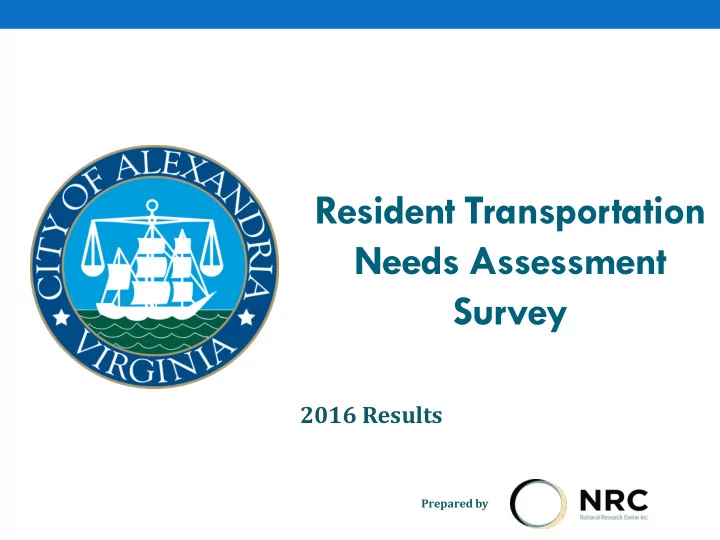

Resident Transportation Needs Assessment Survey 2016 Results Prepared by
Survey Methods 3,000 3,000 households households 801 completed 801 completed surveys (28%) surveys (28%) 3.5% Margin of 3.5% Margin of Error Error Results Results weighted weighted
Modal Share of the Work Commute
Work Commutes Residents employed Modal Share of full- or part-time Work Commute Trips 48% Driving Alone Metro Rail 14% Walking 84% 12% Bus 8% Working at home 6% Carpooling/Driving 5% with Others Bike/Bikeshare 3% 3% Other modes
3 in 5 Respondents had made at least one work commute trip by driving alone Used Metro Rail 3 in 10 Walked
Reasons for Driving to Work 57% 36% 22% 20% Quickest/ Most Public Need/want Irregular convenient to run work transportation takes too errands schedule long
Mode Choices for Non-Commute Trips
Non-grocery Grocery store errands Drove Drove 87% 81% Walked Walked 31% 27%
Drove 72% Walked 38% Restaurants Taxi/Uber 16% Drove Parks and 39% recreation Walked 36% centers Drove 50% Fun or Walked 52% fitness Biked 14%
Active Transportation (Walking and Bicycling)
53% Walk or bike as a means of transportation 4 5 in respondents Walk or bike for fun or exercise
2 in 3 would walk or bike more if there were more off-street walking , biking or multi-use paths and trails If they felt more safe from traffic 6 in 10 More street lighting after dark *Percent strongly or somewhat agree
Public Transportation
What Might Increase Use of Public Transportation • Travel time less than if 8 10 in personal vehicle used • Services more frequent • Services more reliable • More direct routes/fewer transfers 7 10 in • Routes that stopped at my desired destinations
Factors Influencing Mode Choices
14% Indicated that they have difficulties that might impact their transportation choices 9% Climbing stairs 6% Lifting or carrying a package or bag 5% Walking one-quarter of a mile *Respondents reporting difficulties with these activities
Households with a Commuting Modes passenger vehicle 51% Driving alone 91% Bike 3% Metro Rail 13% Households Commuting Modes without a vehicle Driving alone 17% Bike 5% 9% Metro Rail 27%
Households with a Commuting Modes useable bicycle 44% Driving alone 57% Bike 6% Metro Rail 13% Households Commuting Modes without a bicycle Driving alone 51% Bike 0% 43% Metro Rail 16%
Transportation of School-Aged Children
Transportation to School 34% 30% 31% 24% Dropped off by School bus Carpool with Walk driver family
Barriers to Using Modes Other Than Driving Inconvenient Distance Takes too to school long
QUESTIONS?
THANK YOU! Erin Caldwell Director of Research National Research Center
Recommend
More recommend